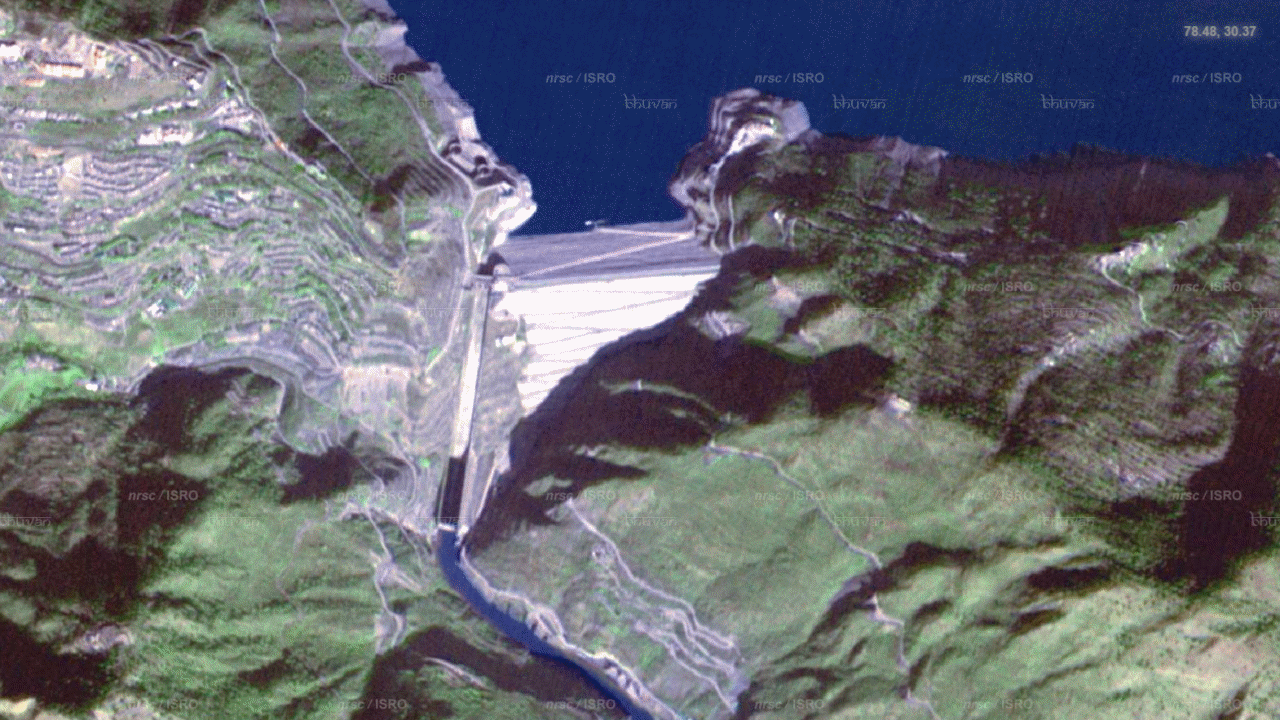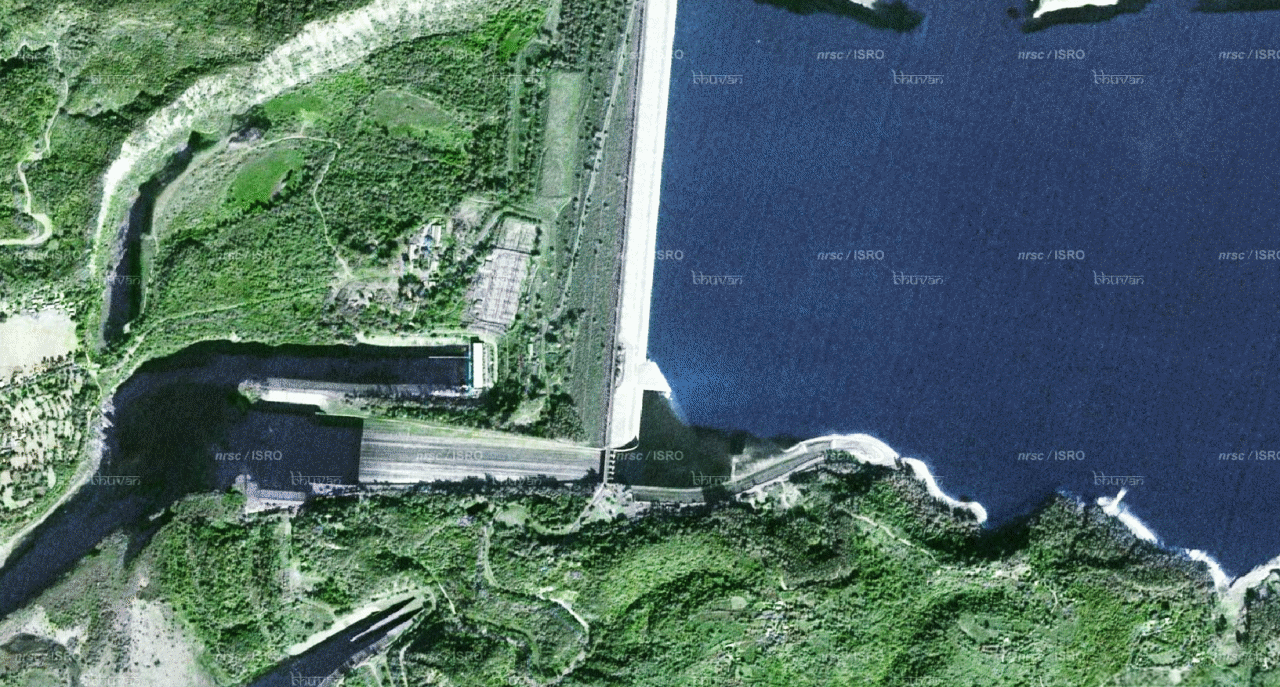
[[en]]Illustration 1: Tehri Dam, Uttarakhand[[hi]]चित्र 1: टिहरी बांध, उत्तराखंड

[[en]]Illustration 2: Pong Dam, Himachal Pradesh[[hi]]चित्र 2: पोंग बांध, हिमाचल प्रदेश
[[en]]Hydro-electric power plants use dam to retain water in a natural or artificial lake or sometimes a watercourse, and divert the same to a turbine that generates mechanical energy. This is attached to an alternator for generating electricity (Czisch 2011). [[hi]]जल विद्युत ऊर्जा संयंत्र प्राकृतिक या कृत्रिम झील या कभी-कभी एक जलकुंड में पानी बनाए रखने के लिए बांध का उपयोग करते हैं, और उसे एक टरबाइन की ओर मोड़ते हैं जो यांत्रिक ऊर्जा उत्पन्न करता है। यह बिजली पैदा करने के लिए एक अल्टरनेटर से जुड़ा होता है (ज़िस्क 2011)।
[[en]]Hydropower plants are costly to install but cost-effective to operate. The key advantage of hydroelectric power is the ability to store energy and the flexibility of its use during peak load periods (Planning Commission, 2002).[[hi]]जल विद्युत संयंत्र स्थापित करना महंगा है लेकिन इसके संचालन की लागत प्रभावी है। जल विद्युत का मुख्य लाभ ऊर्जा को स्टोर करने की क्षमता और उच्चतम उपभोग अवधि के दौरान इसके उपयोग का लचीलापन है (योजना आयोग, 2002)।
[[en]]Types of hydro power plants (Czisch 2011):[[hi]]जल विद्युत संयंत्रों के प्रकार (ज़िस्क 2011):
[[en]]Run-of-river hydropower plants [[hi]]नदी प्रवाह वाले जल विद्युत संयंत्र [[en]]the inflow directly for electricity supply without significant storage capacity. In some cases changes in water level can be utilized for storage purposes to a limited degree. This operating mode is referred to as hydropeaking.[[hi]]अधिक भंडारण क्षमता के बिना बिजली की आपूर्ति के लिए सीधे जल के प्रवाह का उपयोग करते हैं। कुछ मामलों में जल स्तर में परिवर्तन का उपयोग सीमित उद्देश्यों के लिए भंडारण हेतु किया जा सकता है। इस संचालन मोड को हाइड्रोपीकिंग कहा जाता है।
[[en]]Impoundment hydropower plants[[hi]]इमपाउंडमेंट जल विद्युत संयंत्र[[en]] collect the inflow in reservoirs with capacities that, in many cases, are large enough for generating at full load for several months. Inflow and generation can thus largely be decoupled. The storage hydropower plants only use part of the water impounded immediately.[[hi]] ऐसी क्षमता वाले जलाशयों में प्रवाह को इकट्ठा करते हैं, जो अक्सर कई महीनों तक पूर्ण क्षमता पर बिजली बनाने के लिए पर्याप्त होते हैं। इस तरह से इनफ्लो और बिजली बनाने को काफी हद तक अलग किया जा सकता है। स्टोरेज जलविद्युत संयंत्र केवल तुरंत लगाए गए पानी के हिस्से का उपयोग करते हैं।
[[en]]Pumped storage hydropower plants[[hi]]पंप भंडारण जल विद्युत संयंत्रों[[en]] no significant inflow but have a reservoir that is filled from a lower reservoir using pumps. The potential energy of the water stored at the higher level is used for electricity supply, usually to cover peak demand.[[hi]] का कोई महत्वपूर्ण इनफ्लो नहीं होता है, लेकिन एक जलाशय होता है जो पंपों का उपयोग कर निचले जलाशय द्वारा भरा जाता है। आमतौर पर उच्चतर मांग की आपूर्ति करने के लिए, उच्च स्तर पर संग्रहित पानी की संभावित ऊर्जा का उपयोग बिजली की आपूर्ति के लिए किया जाता है।
[[en]]India is endowed with economically viable hydro potential. The Central Electricity Authority (CEA) has assessed India's hydro potential to be about 148,700 MW of installed capacity (Planning Commission, 2002). The total installed capacity of large hydro-electric power plants in India is 48,038 MW, including 4935 MW of pumped storage hydropower plants as on March, 2018. Naptha Jhakri Hydro Power Plant over Sutlej River in Himachal Pradesh is the largest hydro-electric power plant in India with an installed capacity of 1,500 MW. Illustration 1 shows the very high resolution satellite image of Tehri Dam in Uttarakhand with 1000 MW Hydro Power Plant. Illustration 2 shows Pong Dam in Himachal Pradesh with 396 MW Installed Capacity Hydro Power Plant. [[hi]]भारत आर्थिक रूप से व्यवहार्य जल विद्युत क्षमता से संपन्न है। केंद्रीय विद्युत प्राधिकरण (सीईए) ने भारत की जल विद्युत क्षमता 148,700 मेगावॉट आकलित की है (योजना आयोग, 2002)। भारत में मार्च, 2018 तक बड़े जल विद्युत ऊर्जा संयंत्रों की कुल स्थापित क्षमता 48,038 मेगावॉट है, जिसमें 4935 मेगावॉट के पंप भंडारण जल विद्युत संयंत्र भी शामिल हैं। हिमाचल प्रदेश में सतलज नदी पर बना नत्था झाकरी हाइड्रो पावर प्लांट 1,500 मेगावॉट की स्थापित क्षमता के साथ भारत में सबसे बड़ा जल विद्युत संयंत्र है। चित्र 1 उत्तराखंड में टिहरी बांध की 1000 मेगावॉट जल विद्युत संयंत्र के साथ उच्च विभेदन उपग्रह छवि दिखाता है। चित्र 2 हिमाचल प्रदेश में 396 मेगावॉट स्थापित क्षमता वाले जल विद्युत संयंत्र के साथ पोंग बांध दर्शाता है।
[[en]]The hydro-power plants smaller than 25 MW Installed Capacity are called Small Hydro Power Plants. The total installed capacity of small hydropower plants in India is around 4000 MW as on March, 2018. [[hi]]25 मेगावॉट से कम स्थापित क्षमता वाले छोटे जल विद्युत संयंत्रों को लघु जल विद्युत संयंत्र कहा जाता है। मार्च, 2018 तक भारत में छोटे जल विद्युत संयंत्रों की कुल स्थापित क्षमता लगभग 4000 मेगावॉट है।

[[en]]Illustration 1: Tehri Dam, Uttarakhand[[hi]]चित्र 1: टिहरी बांध, उत्तराखंड

[[en]]Illustration 2: Pong Dam, Himachal Pradesh[[hi]]चित्र 2: पोंग बांध, हिमाचल प्रदेश
[[en]]References:[[hi]]संदर्भ:
Czisch, G., 2011, Scenarios for a Future Electricity Supply, The Institution of Engineering and Technology, London, United Kingdom.
Planning Commission, 2002, Tenth Five Year Plan 2002-07, Government of India, New Delhi.